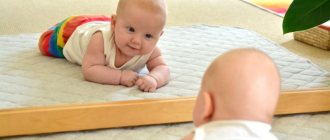The time when a child begins to sit on his own is very individual. Many fathers and mothers want their baby to develop quickly and correctly, and the outstripping achievements of their peers begin to cause concern, especially for young parents.
But you should not put your desires above the health of your child. There are certain norms for the development of children, which are confirmed by the knowledge of specialists in this field. And the question of at what time should a baby sit on his own is a very serious one, because the future health of the child depends on it.
When the baby starts to sit down
The baby is in a lying position from birth. As he grows and develops, he acquires new skills: holding his head, grabbing toys, turning on his side, and later from his back to his tummy and back, trying to crawl. At some point, the baby wants to change his position, trying to raise his head and take a sitting position. After all, this changes the viewing angle, many things are seen differently, and it becomes more interesting for the baby to explore the world around him.
Many children grab the sides of the crib or stroller and try to sit up. If you invite them to hold their fingers and give them a little help, they will take a “sitting” position for a few seconds. They cannot sit for a long time yet. They say that the child begins to sit down, that is, to sit down for a short time.
Some parents are in a hurry to cover the baby with pillows so that he sits longer, but this should not be done. Everything has its time. The child should sit up on his own when his spine is ready for this. At what age does a child begin to sit? Each child has his own pace of development. However, there are certain average statistical norms for when you can start sitting your baby down. According to statistics, babies go through the following stages:
- 6 months – sitting with support;
- 7 months – sitting without support;
- 8 months – sits up independently.
Some children begin to sit down earlier. However, sitting in a sitting position is not recommended for children under 6 months of age.
You can tell if your baby is ready to sit down by the following signs:
- The baby has learned to roll over onto his stomach and back onto his back;
- Raises the head from the “lying” state, holds it well;
- Tries to rise to his feet, holding onto support;
- Raises the body well, holding onto the parents' fingers.
- Can hold the backrest for some time in a sitting position.
If all these skills are observed in a child, then soon the baby will learn not only to sit himself, but also to take a sitting position on his own.
Is it possible to place a child on purpose?
Every mother wants her baby to develop faster, and when the child begins to sit up, parents receive significant relief.
Most children at 5 months can already hold their back if you help them sit up. Some parents are in a hurry to quickly cover the baby with pillows, thinking that this will help consolidate the result. Especially representatives of the older generation are very fond of giving such advice. But you need to be as patient as possible and wait until your baby is ready.
By deliberately seating your baby before he starts doing this himself, you can seriously harm his spine. If the child does not sit up on his own, it means his back is not yet strong enough and is not ready for this load. But even if the baby sat up on his own at 5–7 months, you cannot fix him in the “sitting” position with pillows!
How can you understand that the time when a child should sit independently has not yet come? The baby falls on its side, its back rounds while sitting. Children should not be deliberately placed before the age of seven months.
Sitting early puts a lot of stress on the spine, but in infants it is still soft, the cartilage can easily move. Such haste in the future is fraught with curvature of the spine, deformation of the pelvic bones and other negative consequences.
https://youtu.be/Bsk1WUy-KFs
Is it possible to sit down? The dangers of untimely sitting down
At birth, the baby's spine is very flexible and soft, but is easily deformed. It is designed for lying position only. With age, the spine strengthens, the necessary curves appear, and a muscle corset is formed. Therefore, it is not recommended to sit children down early.
If a child does not hold his back well, rounds it too much, or falls to the side or forward, there is no need to cover him with something for support. Such a child is not ready to sit down. This can cause harm to a fragile spine. Most often, spinal deformation occurs in childhood and is associated with early sitting down, walking, and stress on the undeveloped muscular corset that supports the spine.
At how many months a child will begin to sit depends on the state of his muscle development.
The more actively a child tries to move, turn, change body position, the faster his back will strengthen, and he will begin to sit, stand, and walk earlier.
Therefore, it is useful to lay the child on his tummy so that he lifts and holds his head and body, leaning on his forearms, and then his hands, teach him to roll over, and do special gymnastics for babies. Crawling is very useful for a child. If a child has learned to crawl, then it is very comfortable for him to sit down from this position. In addition, it helps relieve the load on the spine and strengthens all the baby’s muscles.
Useful tips
To make caring for a baby easier these days, there are many devices. But parents should know which aids may be harmful at a certain age of the baby.
- It is not recommended to use baby tables and car seats without a lying position before 6 months. Today there are many models of car seats on the market for any age. The main thing is that the baby lies or reclines, but does not sit in it;
- A baby kangaroo carrier is very convenient for moms and dads, but it should also not be used for children under six months old. It will have a negative impact on the fragile spine;
- If you are carrying a baby in your arms, then you need to lightly press him towards you so that he seems to be lying on you. In this position, the load on the spine will be minimal.
All normal parents want their children to be healthy and strong. It is important to remember here that a lot depends on their attitude towards the child. Any failures in the development of a baby at a very early age can later result in serious problems. Now you know at what month a child begins to sit and what not to do so as not to cause harm. Therefore, be more attentive to the health of your children!
Stages of mastering the skill of sitting
Attempts to take a sitting position in a child appear quite early at 3-4 months. But mastering this skill is not easy for him. The baby learns to sit gradually, acquiring certain preparatory skills. The stages of mastering the ability to sit are not always the same. In most cases it happens like this:
- The child tries to raise his head and upper body, trying to sit up . If you give him some fingers, he grabs it and rises for a few seconds. This stage occurs in children at different times around 3-5 months.
- A baby at 4-6 months clings to a support, kneels down, tries to sit up , but still cannot hold on, falls on his side or backwards;
- At 5-6 months, the child sits down with the help of a parent , holds his back for several minutes, can turn on his side and try to sit up, leaning on his hand;
- At the age of 6-8 months, he sits confidently, holds his back well , but often still uses the help of an adult to sit down, although some can sit down independently;
- 7-10 months – sits down independently from any position , can turn to the side, plays with toys while sitting, easily changes position: stands up, lies down, gets on all fours and back.
In some cases, the child first turns over on his tummy, gets on all fours and sits down from this position. Children often start crawling and then learn to sit up on their own.
Some children are able to sit up to 6 months, but experts do not recommend spending a lot of time sitting at this age. It is better if the baby sits for 10-15 minutes several times a day. Gradually the time can be increased.
Other children, on the contrary, cannot learn to sit down or sit confidently for a long time. It happens that they develop such a skill only at 9-11 months. This is also the norm. There is no need to rush the baby.
If a child is healthy and has no physical or neurological pathologies, then he will definitely learn to sit earlier or later than his peers.
Basic exercises with a newborn
Not everyone knows, but starting from the first weeks of life, the mother can do exercises with the baby that will have a beneficial effect on the little one learning to sit in a timely manner. Regular exercise and a relaxing, even light massage will also have an important impact. It is important to start with a very small and almost imperceptible load, which will gradually increase as the baby grows up. In addition to the fact that physical exercise will have a beneficial effect on the development of the musculoskeletal system, and, accordingly, gross motor skills, it will also help strengthen the protective functions of the body.
A newborn can do the following exercise: place the baby on his tummy, starting after two weeks from the date of birth. It is this exercise that will help the child begin to hold his head up, then master the skills of turning over on his own, and then the toddler’s gross motor skills will improve until he acquires the ability to rise to a sitting position and be confident in it, and then walk.
We recommend reading:
How to place baby on tummy
How to teach a child to roll over
What to do if your baby doesn't want to sit
Some mothers begin to worry if at a certain age their child still does not know how to sit, while his peers have long acquired this skill. Parents are wondering what to do and how to teach their child to sit? However, there is no need to worry ahead of time. If the baby has sufficiently mastered other motor skills, rolls over, gets on all fours, crawls, tries to get up, then you don’t have to worry until 11 months. It is better to encourage the child to crawl. This will help strengthen the muscles, and he will learn to sit down sooner.
How long does a child’s 1-year crisis last and how should parents behave?
Let's figure out what time a child begins to walk, how to help the baby master this skill, and in what cases should you worry?
We act smoothly, without rushing
Parents often train their children to sit independently by covering them with pillows on all sides, but this often ends with them simply falling over on their side.
As mentioned above, this is proof that the child is not ready to sit . In addition, such early experimental attempts to plant a baby can end in failure, namely the development of problems with the spine, including scoliosis, and therefore it is better to abandon them immediately.
In order for the learning process to go smoothly, there is no need to rush; it is better to start with the basics. First of all, physically prepare your baby for sitting, that is, conduct frequent short-term training with him, which will help strengthen the muscles of the back, neck and abdomen.
For these purposes, a whole set of special exercises has been developed that the baby can successfully perform together with his parents.
But, before you start the exercises themselves, it’s worth thoroughly “warming up” the baby with a simple massage and gymnastics, which you do daily.
Stroke the arms, legs, tummy and back - activate the circulatory system, spread the arms to the sides and up, cross them on the chest, gently bend and straighten the legs at the knees, spread the bent legs to the side and fold them together, according to the principle of opening a book, imitate walking , resting your feet on a hard surface, touch your bent knees to the pile of the cage and do the “bicycle” exercise.
In general, conduct standard activities with your child, which take no more than 5-10 minutes.
After the body is ready to “work”, you can begin performing exercises that train the necessary muscles.
When to worry
You should be worried if the baby lags behind in development from the first months. Most likely, the doctor will notice this and refer the parents to a neurologist.
If at the age of 6-8 months he cannot roll over onto his tummy and back, does not try to crawl, sit down, or stand up, then he clearly has neurological problems and should be shown to a specialist.
If there are no problems, then most likely it will be enough to undergo a course of special massage and gymnastics. However, this must be decided by a specialist.
Preparing to do the exercises
How to help a child sit up on his own? Classes should be based on special gymnastics. As for treatment, it should be carried out exclusively by a specialist. But most of the exercises are so simple that doing them at home is not difficult for parents.
Before you start gymnastics, you must adhere to the following recommendations:
- Exercises can be performed no earlier than an hour after eating.
- Before gymnastics, it is necessary to ventilate the room.
- The baby should be in a good mood.
- The child’s clothes should be selected from natural fabrics.
- The diaper must be removed.
- Before starting gymnastics, you should warm up the baby’s muscles with a bath or light massage for 5–10 minutes.
- All exercises must be performed slowly and smoothly.
- The fitball must be at least 70 cm in diameter. Choose a ball with a smooth texture and invisible seams.
- Before you start exercising on the fitball, cover it with a diaper.
- When performing exercises, hold your baby by the torso or hips.
- During classes, talk and play with your baby. He should experience positive emotions.
How to teach sitting? Exercises
What can parents do to help their baby learn to sit? Gymnastics, massage, swimming in a bath or pool are best for this. Such activities will help develop the back muscles and correctly form the muscular corset of the spine.
From the age of three months you can perform the following exercises with your child:
- Position of the baby lying on his back . The mother extends her index fingers to him, the child grabs them and tries to rise to a 40-degree backrest angle. Stay in this position for 3-5 seconds and lower the baby. Run several times.
Gradually, the lifting angle and holding time can be increased.
- From 6 months, you can complicate the first exercise by lifting the child with only one arm . The second he tries to hold on and lean on his own.
- The child is supported under the chest and under the stomach, the back is up, the legs rest against the adult’s stomach . Raise the child's torso and lower it. The baby's head is raised up. Muscles are tense. Hold for a few seconds and lower.
- Place the child on his side so that he turns over onto his stomach, then back again . You can attract toys so that the baby reaches for them.
- Rocking the child on a fitball also helps . Holding the child lying on the ball, we rock the ball up and down, either bending the child’s legs or touching the surface with his hands. You can swing the ball left and right.
Massaging the muscles of the arms, back, and legs helps a lot. Hand movements are kneading and stroking; light patting is acceptable. The movements are directed from the bottom up from the fingers to the shoulders.
For children older than 6-8 months, if they do not crawl, then gymnastics is aimed at acquiring this skill. Then the baby will learn to sit up on his own.
Swimming has a very beneficial effect on all the child’s muscles, strengthening them without putting strain on the spine. If it is not possible to visit the pool with your baby, then you can limit yourself to swimming in a full bath.
All the baby’s skills are interconnected, so it is important not to miss the moment when it is worth helping the baby - doing massage, gymnastics. The next skill after the ability to sit down is crawling; how to teach a child to crawl on all fours, read our next material.
Kids grow up quickly, and you won’t even notice when the time comes to introduce discipline and punctuality to your little fidget. How to teach your child to understand time by the clock in a playful way - read our link.
Exercises to strengthen muscles
If a baby cannot sit up on his own even at 9 months, this is not a reason to panic, but a consultation with a doctor will not be superfluous. He will determine if there are any health problems.
In addition, every mother should know several exercises that can help the baby. For example, these:
- The baby is lying on his back, take him by the arms, he will try to sit up. We hold him in this reclining position for several seconds. We repeat the exercise. You can lift it by one hand or the other, in turn, very carefully.
- Turn the sitting child's back to you. Use your hands to support your baby's elbows. He must reach for objects, take them out and return to the starting position.
- Place the child facing you. Hold it by the handles and swing it from side to side. You can hum some children's song.
- The walking exercise strengthens the muscles. Hold the baby by the armpits, he will begin to move his legs reflexively.
- From a lying position, bring the child’s legs/arms to the wall - he will begin to push off. These exercises will strengthen the muscles of your legs, arms and back.
- The “figure eight” exercise will improve muscle tone: move the baby along the water surface in the form of this number. Squats in water are also useful.
Water procedures are very useful - all the baby’s muscles are well trained, and the load on the spinal area is very small. You can perform a whole range of exercises in the bathroom, and if possible, it is better to sign up for the pool.
Riding on a large ball, on the back and on the tummy trains the baby's muscles well. The baby will really like these exercises, especially if you talk to him constantly.
If the baby crawls well, but does not yet know how to sit, then you should not panic even at 9 months. Many parents are very worried about this, but they just need to help the baby a little. The main thing is that there are no problems with the musculoskeletal system or any neurological disorders. In due time he will sit up without outside help.
Gradually teach your baby to sit in a high chair. You need to start with a few minutes, then increase the time. The seat tilt should be no more than 40–45 degrees.
Boys and girls
You can often hear rather contradictory opinions about whether boys or girls develop faster and sit down earlier. There is information that girls begin to try to sit up earlier, but master this skill later than boys. In addition, some people think that girls' spines are more fragile than boys'. Therefore, they should sit down later. However, there is no reliable evidence for such claims. Everything depends on the individual development of the child. The only thing that is clear is that it is not worth sitting a child down before he sits down himself, regardless of his gender.
There is no need to compare your baby with other children. Each child is unique and has its own biological rhythm. Rejoice at every skill your baby has, help him develop correctly, but don’t rush him. A healthy child will definitely master all the necessary skills, including sitting.
Signs of readiness
Watching your baby, you will be able to notice that his body is strong enough and correctly formed, and has acquired all the necessary gross motor skills in order to learn to sit independently. This time approximately falls at six months of age. Characteristic signs of readiness are:
- The baby holds his head up on his own.
- Can easily make rollovers, both from back to stomach and back.
- The child, when lying on his stomach, raises the upper part of his body, leaning on his hands.
- The little one, when lying on its back, raises the upper part of its body at least for a short time.
- Can practically sit down, clinging to the hand of an adult with its hands.
The presence of these skills indicates that the baby’s muscles are ready for a new load such as independent sitting.
From what position does the child usually sit up on his own?
The child should not sit up from a lying position; the following options are normally acceptable:
- from a side position. The baby begins to sit up with the help of his hand, which will play the role of support;
- from a tummy position. He sits down, pulling his leg under him and helping him push off with his hands;
- standing on all fours. Pediatricians call this the most correct way. Raising his torso, the baby begins to lean back and sits down.
Mistakes parents make
During the period when a child is learning to sit down, it is very important to help him correctly and not harm him. Even small mistakes and inaccuracies have their consequences, including serious problems with the musculoskeletal system. So, common mistakes made by moms and dads, and tips for eliminating them:
- You don't need to pile a bunch of pillows and blankets around your baby while he's practicing sitting up. As a result, stoop often appears and postural disorders develop.
- A common practice among mothers is to sit the baby by the arms when he lies on his back. This is harmful and dangerous, and can also cause lumbar kyphosis (forward curve of the spine). The most correct way to sit down is on all fours.
- It is better to entrust procedures and gymnastics with a newborn infant to a pediatric orthopedist, neurologist or other specialists.
- You can’t immediately place your baby on a hard chair or floor, as this puts a lot of stress on the spine that is not yet fully strengthened. At first, you need to put something dense and elastic, but not too soft.
How to understand that the child will sit down soon?
A sign that the baby will try to sit up is a straight back when standing upright. This is an indicator of his readiness to sit down.
To understand that the child is ready to sit down, pediatricians check the condition of the back muscles: you need to hold the baby vertically by the legs and hold the chest with your hand.
If a child begins to fall to the side or backwards, his shoulders droop - this is a sign of insufficient development of the musculoskeletal structure.
The quieter you go, the further you'll get
The development of each child is not subject to any strict age indicators and norms. The fact that one learned to do something early, and the other learned later, does not mean the presence of a deviation. Often mothers and fathers rush things and, without proper preparation, begin to teach an immature small child to sit down, not realizing that sitting is a natural reflex that does not need to be specially taught. All you need is a set of workouts that strengthen the bones and muscle system. It is important to remember the following: you cannot train an infant or newborn child; the baby must later make his first attempts to sit up himself.
Previous post When does a baby start to crawl - at how many months do babies crawl on their own?
Next entry Vitamins for children - rating of the best children's multivitamins and multivitamins
Exercises in water
You can and should introduce your child to water from the first days, because bathing not only helps maintain hygiene, but also strengthens the child well, and can also be a soothing ritual of preparation for bed. Some babies are afraid of water - in this case, you can not fill a large bath, but use a small children's bathtub or a bathing slide. The slides are designed to place the child in a reclining position and rinse him with water. If he screams and is worried, do not insist and complete the procedure.
"Swing"
. Gently gradually immerse the baby in the water, holding him under the chest with both hands. Rock from side to side so that the child feels the gentle resistance of the water.
"Repulsion"
. Holding your baby in your arms, bring him to the edge of the bathtub so that he can touch the edge with his feet and push off.
"Swimming"
. Place a bright and interesting toy on the water. Holding your baby under his belly, help him swim towards her.
"Zigzags and Eights"
. Place your baby on your stomach or back and, holding him, make zigzags or figure eights with him.
A little about slings and backpacks
When a baby is placed in a sling or a kangaroo backpack, can this be considered forced disembarkation? It all depends on the design of the backpack or the exact method used to tie the sling. Situations in life are different, sometimes such “carrying” is the only possible option. In this case, just make sure that the baby is in a comfortable position. It is also important not to place the baby in a sling or backpack for a long time. A child who does not move enough is unlikely to learn to sit correctly in time.











